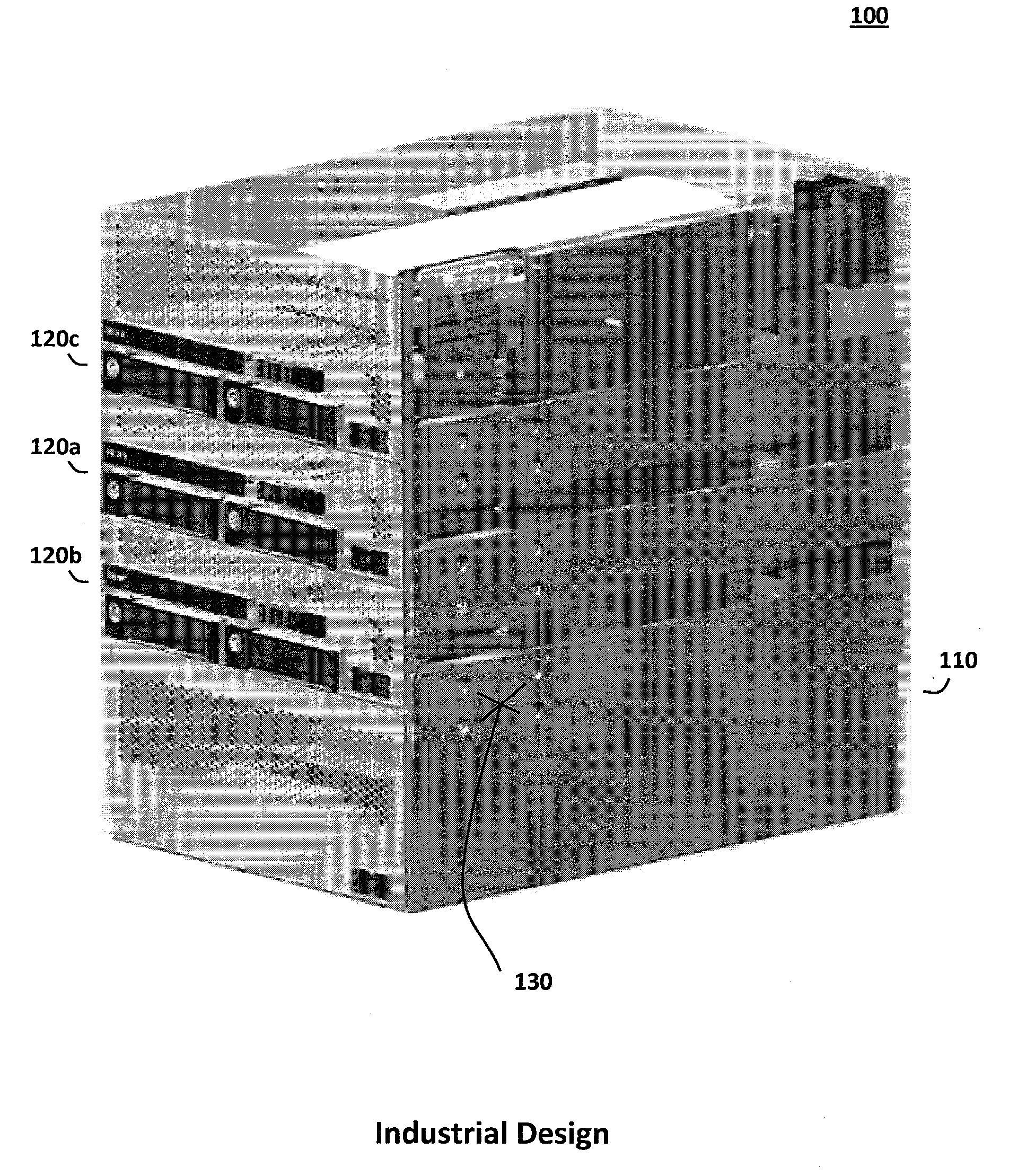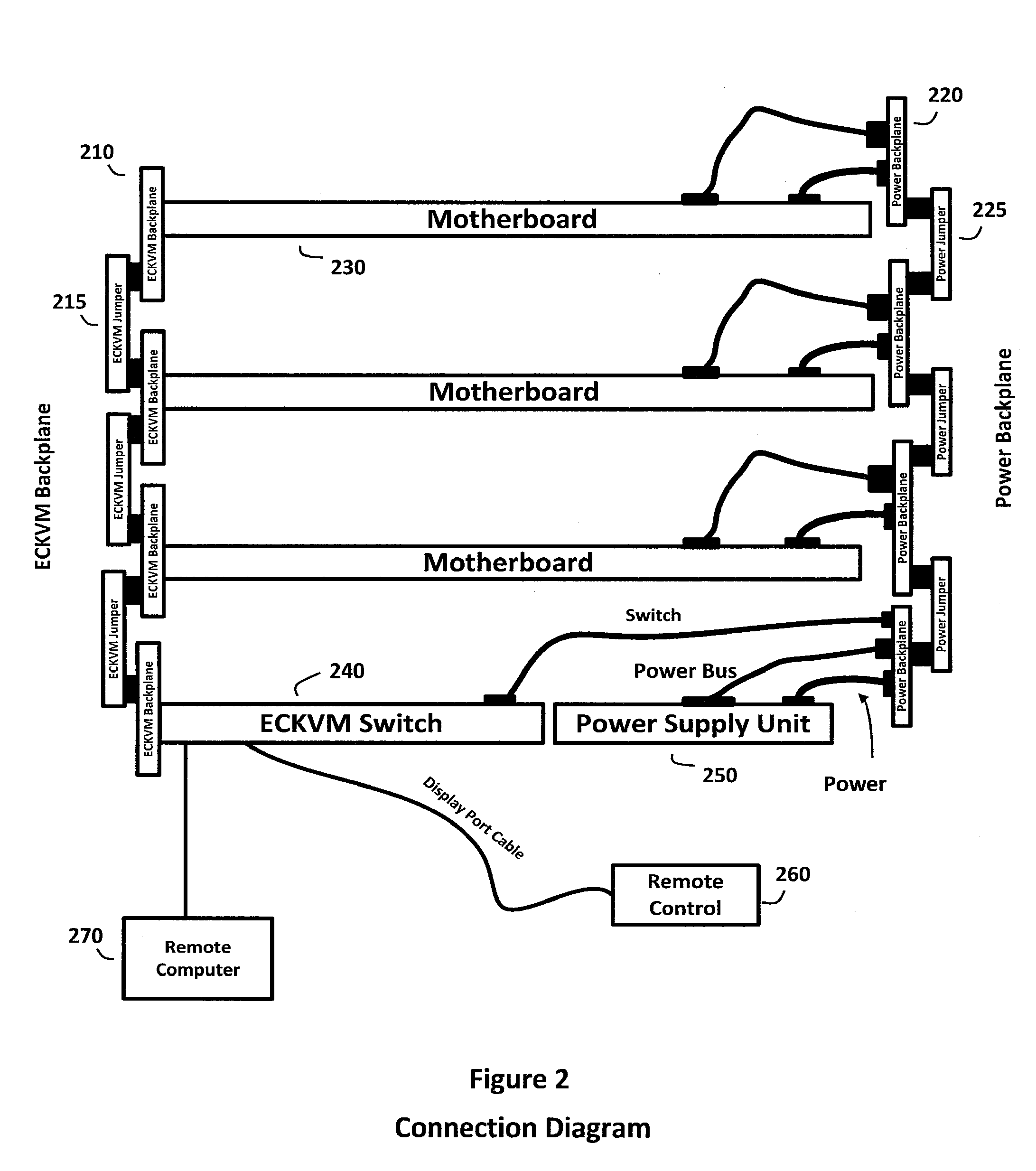[0006]According to one aspect of the invention, the adaptive computing system described herein may have a modular control, switching, and power supply architecture. In particular, the adaptive computing system described herein may provide a platform that represents a forward-looking desktop design that may address
user needs to deploy multiple computers in a
work space. In one implementation, the design associated with the adaptive computing system may further address concerns relating to
power consumption and thermal output in small areas, suitable physical dimensions in limited work spaces, simplified cabling and deployment, and low
initial cost, among other things. Further, the adaptive computing system may maintain current approaches to
software deployment and system management and provide users with flexibility to manage devices deployed on the platform to achieve a multiple desktop solution. For example, the adaptive computing system may permit users to deploy various computer modules that have different processor and memory configurations, while having identical motherboards to simplify deployment on the platform. Further, relative to traditional desktop computers, users may realize savings in the space needed to deploy the adaptive computing system, the power that the adaptive computing system consumes, and the heat exhausted into the space surrounding the adaptive computing system, among other things. Moreover, the adaptive computing system may be convenient to operate, especially to users who may have previously relied on multiple desktop computers and keyboard-video-mouse (KVM) switches to interconnect the multiple desktop personal computers. In one implementation, the adaptive computing system described herein may include a modular control, switching, and power supply architecture to provide a design that can meet the needs associated with diverse user communities, as will be described in further detail herein.
[0008]According to one aspect of the invention, the base module, the power and ECKVM backplanes, and any computer modules deployed in the stack may be enclosed within small, rectangular housings, which may be electrically connected via electrical interconnections in the power and ECKVM backplanes, while the housings may include various tool-less mechanical alignment and securing mechanisms to mechanically connect and secure the base module, the power and ECKVM backplanes, and the computer modules in a vertical stack. In a smallest deployment, where the stack includes one
computer module with a discrete power supply, the
computer module and discrete power supply may combine to have a height approximately two-thirds smaller than a standard mini-
tower (i.e., approximately 145 millimeters, whereas standard mini-towers typically have an approximate four-hundred and thirty-one
millimeter height). Furthermore, in larger deployments the stack may include the base module in addition to multiple computer modules (e.g., up to three computer modules), whereby the combined stack may have different heights that nonetheless remain smaller than a standard mini-
tower. As such, the design may take the various possible heights into account to ensure that the stack will be sufficiently stable to remain upright and tolerate forces exerted on the upper modules without falling over, whereby the design associated with the adaptive computing system may prevent
data loss and reduce
injury risk that could otherwise occur if the stack were to fall. For example, in many (or most) cases the adaptive computing system will be deployed on the floor, which may typically have a low-
pile carpeted covering that does not easily maintain an object in a vertical position, the design associated with the adaptive computing system may employ modern manufacturing methods and materials to provide stability, safety, performance, image, and easy
assembly and service, which tend to be important factors that users consider when making decisions relating to what computer to purchase.
[0009]According to one aspect of the invention, to ensure that the adaptive computing system will be stable and safe to end users, the base module may have a
safety design that can prevent accidental shock or potential injuries. For example, because the stack may include multiple computer modules (e.g., three or more computer modules), the base module may need to provide 1.5 kilowatts (kW) into the stack to power the various components deployed therein, wherein the
safety design may include various mechanical and electrical lockouts that can prevent the stack from powering on while a lid or any other modules are removed or improperly seated. Furthermore, the
safety design may be documented and tested through independent product safety certification organizations, such as Underwriters Laboratories Inc. (“UL”), and
quality control processes may be employed during manufacturing to check and validate that the safety lockouts function properly before any system will be shipped to the customer. In one implementation, to ensure that the adaptive computing system will be easy to assemble and service, the housings associated with the base module, the power and ECKVM backplanes, and any computer modules deployed in the stack may comprise tool-less
chassis, which may provide strength and stability to the overall stack. As such, any major components may be installed in and removed from the base module, the power and ECKVM backplanes, and any computer modules deployed therein without any tools. In addition to simplifying assembly and service, the tool-less
chassis design may ensure safety and quality. For example, because a user unlocking the lid or another housing may potentially move levers or other mechanical objects in the stack, the tool-less
chassis may be designed to disengage certain modules from the mechanical retention mechanisms to allow the modules to be easily removed.
[0011]According to one aspect of the invention, the adaptive computing system described herein may eliminate many cables that would otherwise be required to deploy a multiple desktop computer solution to allow users to place the adaptive computing system in any suitable location and improve the overall appearance and
usability in their
work space. In particular, because the platform may enable multiple computer modules to be deployed in a vertical stack, the mechanical and electrical integration employed therein may enable video, audio, and other
signal cables to be moved to a central location without substantially degrading quality associated therewith, which may permit integrating
Ethernet, infrastructure control, KVM, and other switches into the base module and improve
cable management in the overall stack. For example, in one implementation, the ECKVM switch integrated into the base module may
route display,
USB, audio, and other input / output (or KVM) signals from any particular
computer module deployed on the stack to common output connectors on the integrated ECKVM switch, which may be shared with other computer modules deployed on the stack. In one implementation, controls associated with the integrated ECKVM switch may be situated on a
remote control, which may ensure that the other computer modules can be reliably connected to the ECKVM switch and guarantee that mistaken switching will not occur. For example, the integrated ECKVM switch may have a board that directly mounts connectors associated with display, keyboard, mouse,
microphone, speaker, and other input / output or console devices, wherein a rear panel associated with the base module may provide access to the mounted connectors that may be used to connect the various input / output or other console devices to the ECKVM switch. As such, the
remote control may allow users to manage power associated with any computer module in the stack and switch among any computer modules that are operational via the ECKVM switch, wherein two respective cables may connect the base module to the
power management and ECKVM switching elements on the
remote control, thereby substantially eliminating the cables needed to control the multiple computer modules that may be deployed on the stack.
[0012]According to one aspect of the invention, the design associated with the adaptive computing system described herein may therefore provide stability, safety, performance, and easy assembly and service and consider many factors that tend to be important to computer
purchasing decisions across diverse user communities. For example, the computer modules may be designed, tested, and packaged with drivers and other
software compatible with Windows versions, Linux versions, and other
operating system versions that are commonly used in the commercial computer market, and future implementations may include be software-compatible with
operating system versions that may subsequently become more common or popular. Moreover, to reflect that computers tend to represent user personalities and image, color, form-factor, and other designs in the adaptive computing system may generally revolve around themes relating to quality, innovation, integration, and green technology to fit within (rather than dominate) personal environments. In particular, every module, cable, shipping box, or other material used in the design may communicate value, including buttons that users will touch and feel during the computing experience. For example, the adaptive computing system may be designed to have tight fitting connectors, housings constructed with hard plastics and smooth finishes to convey image, and front panels to conceal otherwise exposed storage devices and provide a consistent and organized appearance. Further, in closed positions, the front panels may preserve the consistent and organized appearance, wherein post-market off-the-shelf devices may be installed without causing a dissimilar appearance, and different computer modules may have different front panels having different finish colors to identify computer modules having different characteristics (e.g., computer modules with different security classification domains). Furthermore, average desktop computers tend to use power supplies inefficiently (i.e., typically being shipped with three-hundred
watt power supplies even though most computers only require one-hundred and twenty-five to one-hundred and fifth watts). In contrast, the adaptive computing system may share a common power supply across multiple computer modules to optimize power supply, eliminate
brominated flame retardant (BFR) from all circuit boards used therein, eliminate
polyvinyl chloride (PVC) from all cables used therein, and use recyclable mechanical materials. As such, the platform and functionality associated with the adaptive computing system may be designed to meet or exceed Electronic Product Environmental Assessment (EPEAT®) Gold environmental performance criteria, while packaging material may be substantially reduced without compromising product integrity during shipment to provide additional environmental benefits.
[0013]Accordingly, the adaptive computing system and the modular control, switching, and power supply architecture that will be described in further detail herein may allow multiple independent computer modules to occupy less space than commercial standalone mini towers currently require, and may offer performance density in a desktop solution that can only be achieved currently in a
server solution. As such, the adaptive computing system and the modular control, switching, and power supply architecture to be described in further detail herein may create a new desktop computer metaphor and open new opportunities relating to stability, safety, productivity, performance, assembly, service, and other factors important to modern and diverse user communities.
 Login to View More
Login to View More  Login to View More
Login to View More 


